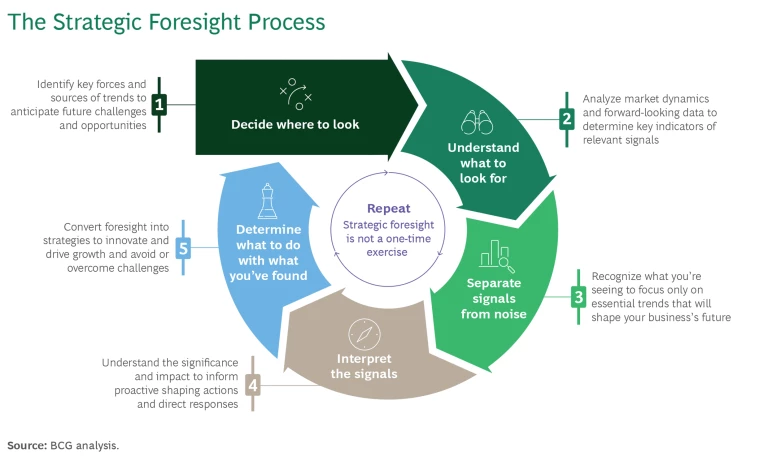“Uncertainty is an uncomfortable position, but certainty is an absurd one,” observed the philosopher Voltaire some 250 years ago. Today, uncertainty can be more uncomfortable than ever, especially for business strategists trying to make sense of volatile and fast-moving markets, economies, and geopolitical circumstances. But new tools and capabilities, especially when used in combination, can transform uncertainty from a source of discomfort to one of competitive advantage. They are rooted in the well-established approach of strategic foresight, and they employ a few contemporary twists. Those who embrace them can anticipate and plan for the future more effectively than competitors.
All too often, strategists attempt to predict the future so they can react to it—an approach that can be fraught with oversimplifications and inaccuracies.
All too often, strategists attempt to predict the future so they can react to it—an approach that can be fraught with oversimplifications and inaccuracies. Strategic foresight, on the other hand, aims to anticipate, analyze, adapt to, and shape the factors that are relevant to a company’s business—better and before competitors. What makes today’s strategic foresight such a powerful capability is that it marries cutting-edge analytics with proven creative tools and artificial intelligence (AI) to empower better, more risk-informed strategic thinking. The process helps executives better understand the alternatives facing their companies and what potential developments could mean for the business. It’s not about gathering more data than everyone else but about being able to detect forward-looking signals, stretch perspectives, and interpret the data with fresh eyes. Uncertainty does not dissipate; rather, strategic foresight offers the clarity of direction that comes from greater confidence in data, assumptions, and analysis.
BCG has built a new generation of strategic foresight capabilities, taking advantage of technological developments and advances in combination with other innovations, including the following:
- The ability to gather a broad array of data from digital devices, sensors, communications, and social media, among other sources
- Supercharging sensing and signal detection with advanced analytics, AI, and generative AI (GenAI) to help make sense of all this data
- More effective applications of historically underused tools—including competitive simulations, scenario planning, and war gaming—that strengthen strategy and build resilience
Here’s how leading organizations are using strategic foresight to identify opportunities and overcome challenges in ways never before possible.
A Good Plan Is Hard to Find
The tools of conventional forecasting, such as inside-out perspectives, linear extrapolation, and annual plans, are well suited to circumstances where change is slow or static. These situations, however, are becoming increasingly rare.
Today’s strategists need to anticipate, detect, and decipher weak signals of potential disruptions (which may actually be materializing fast). They require a dynamic, iterative process that combines rigorous data analysis with imaginative “what if?” explorations to develop stronger mid- to long-term strategies. The use of strategic foresight can help companies anticipate what might be coming—technology innovation, shifts in consumer attitudes, or demographic or climate pressures, for example—so that they can incorporate early signals and resulting contingency actions into their planning. This lets users adjust in real time as signals change.
Strategic foresight can help companies anticipate what might be coming, so that they can incorporate early signals and resulting contingency actions into their planning.
Consider two recent examples. Strategic foresight helped pharmaceutical company Novo Nordisk decide to make early, calculated investments in GLP-1 obesity medications before other industry players. This was a key move in establishing the market for the new class of highly efficacious weight loss and diabetes medicines. Novo Nordisk now has a market-leading position with continuing strong growth. Siemens, a major industrial goods player, spotted emerging trends in demographic change, environmental change, urbanization, globalization, resource efficiency, and digitalization before the rest of the market. This led it to conclude (as it says on its website) that “Smart Infrastructure addresses these topics by combining the real and the digital worlds.” Siemens focused resources on growing its business in this area, and its fiscal year 2023 Smart Infrastructure business was the biggest contributor to an 11% revenue increase for a company with a revenue base of more than $75 billion.
The Strategic Foresight Process
Strategic foresight enables stronger, more resilient strategy by exploring leading indicators of potential change, often using big data, specialized advanced analytics, and AI for a more comprehensive understanding of potential futures. The creative reimagining of the future through scenario planning, war gaming, and strategic risk management puts this understanding in context. We use strategic foresight to focus continuously on identifying and challenging biases, assumptions, and preexisting mental models—especially the hidden or implicit ones—and thinking about how they might evolve or become disrupted. This enables strategists to stretch perspectives and examine inputs and outputs of the analytic tools through different sets of lenses. (See the exhibit.)

The process could be described as following this cycle:
From deciding where to look
To understanding what to look for
To separating signals from noise
To interpreting the signals
To determining what to do with what you’ve found
Then the process is repeated because strategic foresight should be iterative. Along the way, teams learn and become more efficient with each stage of the cycle. They increase their competitive advantage by traversing each cycle faster and better than the one before—and better than the competition’s capabilities.
This process can help companies develop informed points of view on a range of forward-looking questions, such as the following:
- What are the primary trends shaping our industry, and where and how could they affect our business?
- How can we build on existing growth vectors while identifying new, nonlinear, or adjacent opportunities that leverage strategies such as M&A?
- Where and how can we diversify our business to capitalize on opportunities or mitigate threats, allowing us to build resilience and ultimately improve shareholder returns?
- How should we be preparing for disruptions to ourselves or our competitors, be they technology based (such as the next generation of AI, quantum computing, or synthetic biology), geopolitical, climate focused, or regulatory?
- How can we improve our understanding of market capacity and anticipate potential disruptions in capital projects?
The leaders in strategic foresight have deliberate processes in place to confront and solve such dilemmas, and they prepare themselves for the follow-on questions that may arise.
Traversing the Strategic Foresight Process
Strategic foresight is designed to help companies better navigate the shifting frontiers of business and technology, enabling them to stay ahead.
Where to Look. Companies should begin by identifying the key forces that will shape different versions of the future. This involves a comprehensive analysis of megatrends (they may be slow moving, but they have big impacts), including how they can affect your business, unlock new opportunities, and pose undetected challenges. Strategists should put in place mechanisms to detect early or weak signals of emerging forces and technologies, especially those with disruptive potential, before they have a material impact on the industry or the medium-term trajectory of the business and how it competes. Best-in-class strategists maintain a running list of potential shocks and disruptions that might affect them.
What to Look for. An in-depth analysis of market dynamics can reveal what customers truly care about and what competitors are prioritizing, both crucial factors in discovering new growth vectors. Potential new entrants, tech developments, and increased lobbying activity are just a few examples of indicators worth tracking. Leveraging forward-looking data (such as patent filings, scientific literature, startup activity, and “smart money” flows) are ways to understand where and how new ideas may be emerging or gaining traction. Differentiated analytics can spot discontinuities and highlight potentially disruptive developments in adjacent businesses, markets, or sectors.
Thinking critically through a range of different futures can lead to insights that help companies prepare for unforeseen circumstances and capitalize on potential opportunities. For example, participating in war games helps stress test strategic hypotheses, deepen understanding of other actors (such as competitors), and challenge biases and assumptions. Developing a more complete understanding of the company’s current strategic risk capabilities and early warning risk indicators can help strengthen organizational resilience . Building out sensing, monitoring, and reporting capabilities enables companies to spot emerging challenges and opportunities as well as detect shifts in the market and broader business environment.
Separating Signals from Noise. This step is about identifying the essential signals that will shape the future of your industry and business. Successful strategists separate the useful signals from the noise, narrowing scores of potential issues to the handful that really count. They also assess the potential impact of these factors on the business by broadening the scope of consideration to include higher-order and indirect effects. Keep Michael Porter’s guidance in mind: “The essence of strategy is choosing what not to do.”
Successful strategists separate the useful signals from the noise, narrowing scores of potential issues to the handful that really count.
Interpreting the Signals. Those that are first to recognize emerging technologies or social trends can turn them to their advantage or move to neutralize a nascent threat. Going through the exercise of spotting disruptions enables companies to put in place better systems to monitor and track early signals. The art of recognizing the “so what” is a powerful differentiator.
We worked with a large life insurance company to assess the potential impact of GenAI on its business and explore implications of the new technology across potential future scenarios. The process distilled about 100 trends down to 10 that mattered most. From those, the company was able to identify two axes of uncertainty: one involving the development of GenAI technology and the other concerning the evolution of consumer preferences related to GenAI. These led to four potential scenarios to use as tools to stretch management’s thinking in developing strategy. The result was a GenAI playbook that outlined the opportunities and challenges in each scenario, along with an exploration of the strategic initiatives the company could pursue. The playbook included recommended actions linked to each scenario, a decision-making framework for evaluating potential strategic actions, and a list of no-regret moves and big bets for future advantage.
Subscribe to Our Corporate Finance and Strategy E-Alert.
What to Do with What You’ve Found. Once companies have obtained a clear understanding of where the future may lead and the potential implications of those results, they can focus on using this foresight to help inform strategic initiatives that drive growth and innovation. This will allow them to proactively shape and respond to potential disruptions. (Ideally, they will seize opportunities or notice challenges before others do.) We worked with a leader in semiconductor equipment that was facing heavy cyclicality, slow growth, and low profitability in its core business segments. An analysis using strategic foresight surfaced connections between the company’s technology capabilities and new deployment opportunities in emerging industries, and as a result it entered a completely new business sector. The company has since outperformed both its peer set and the broader market by delivering top-quartile shareholder returns of 20% a year from 2014 to 2024.
We also helped a global producer of packaging and decoration materials identify potential disruptors of demand, especially the impact of emerging technologies with the potential to upend its business. The challenge was to build these possible disruptors into the company’s forecasting model when there was no precedent or prior data to model and when demand for its products closely tracked general GDP growth. Obtaining an accurate picture required diving into the emerging technologies to understand who was behind them, the R&D that was underway, the amount of investment involved, and the likely timelines to market. Using our strategic foresight process, the company built a model of disruptive forces and potential permutations that helped it quantify, track, and monitor the timing and magnitude of the disruptions and develop an action plan to get ahead of them.
Repeat. Strategic foresight is not a one-time exercise, nor is it a single journey from start to finish. Rather, it is a process, a cycle—and one that requires continuous learning. The world keeps changing. Enhancing an organization’s adaptability and capacity to navigate future challenges involves continuously monitoring the environment and adjusting strategies as needed. It also requires continuously updating the approach to sensing and processing the intelligence. For example, we helped a major international oil company build an early warning system in dashboard form that resulted in more efficient and faster decision making. The major challenges included:
- Identifying the right internal and external data sources to collect the most pertinent data
- Curating the data and adding context to convert it into critical information to allow better decision making and risk management
- Quickly disseminating actionable intelligence to relevant stakeholders to inform their planning
The system involves both internal and external data feeds, including product inventory levels, staffing, supplier information, supply forecasts, weather data, geopolitical indicators, and social media, among others. Vendor, regional, and economic dashboards highlight the key dynamics and potential disruptions in each area. Executives and their teams access insights and review details across regions and asset classes. GenAI-enabled analytics process data from multiple data sets to derive early warning indicators automatically and serve up options for response.
As strategists confront an increasingly dynamic world, they can leverage strategic foresight to develop different ways of envisioning and then planning for potential futures. A rich and evolving set of tools enables companies to be more agile in the face of uncertainty and develop a more resilient strategy based on broadened perspectives and real-time insights. Being able to move early on big opportunities, turn disruption to advantage, and address emerging problems before they become major threats is an important source of advantage.











